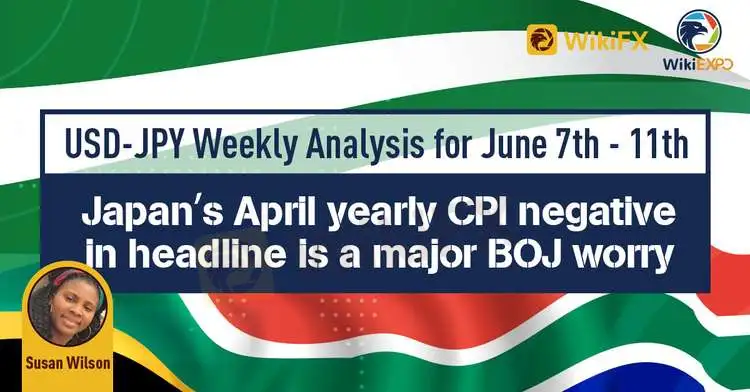简体中文
繁體中文
English
Pусский
日本語
ภาษาไทย
Tiếng Việt
Bahasa Indonesia
Español
हिन्दी
Filippiiniläinen
Français
Deutsch
Português
Türkçe
한국어
العربية
USD-JPY Weekly Analysis for June 7th - 11th Japan's April yearly CPI negative in headline is a major
Abstract:Previous Fed’s minutes once more confirmed market sensitivity to rate indications from the central bank and traders’ fears of not partaking in the possible gush in interest rates and the dollar when that initial sign of a change in policy attains.

Previous Fed‘s minutes once more confirmed market sensitivity to rate indications from the central bank and traders’ fears of not partaking in the possible gush in interest rates and the dollar when that initial sign of a change in policy attains.
Thursdays trading overturned Wednesday's deductions.
The USD-JPY stirred down about 15 points in the Asian and European timeframe on Friday, as the dollar lost battle against many of the majors but not all, with the euro as the principal exclusion.
In economic rating, Japanese figures continue to dishearten.
GDP, Gross Domestic Product, in the first three months of the year let fall bottomless into shrinkage than anticipated in the annualized and quarterly data - 5.1% and 1.3%.
Imports and exports activities in April were the only cheerful spot, climbing 12.8% and 38%, much more than was projected. Also, Consumer prices sustained their deflationary curve last month.
USD-JPY viewpoint
It is tough for USD-JPY traders not to be continually cautious of the US interest rates, questioning when, perhaps unintentionally, the Federal Reserve will release the yield spirit.
US actions remain the determining influence for the USD-JPY. Increasing US interest rates could effortlessly drive the USD-JPY back to 115.00.
The doleful inflation act in Japan may drive the Bank of Japan to action at its June 17 meeting, the outlook of such will keep an offer under the USD-JPY.
The USD-JPY remains entrenched in the tight 108.60-109.70 of the past five to six weeks without any instant cause for travel.

USD-JPY Technical Analysis
With two exclusions the USD-JPY has been trading a slim 108.60–109.70 range since early March. The base of the head-and-shoulder formation wedge from March and April at 109.70 has been the boundary with support at 108.60. The consolidation is exactly portrayed by the USD-JPY move on Wednesday, May 12 when US April CPI was released to be 4.2%, far above the 3.6% predicted. The price action that day underlines the market attention on US rates and the eventual course of yields and the USD-JPY itself.
Momentum pointers offer minimal data in the present situation. The Relative Strength Index and the True Strength Index are almost at midpoint. Also, the MACD is presenting slight indications in this month of May.
With the deficiency of momentum, support and resistance lines take superiority supported by the general bias higher. The neighboring lines above and below have been tried several times. A trivial edge has to be credited to support since it looks doubtful that the US economy will worsen sufficiently to push the USD-JPY below 108.00.
Resistance: 109.20, 109.70, 110.20, 110.75
Support: 108..60, 108.40, 107.90, 107.00

USD-JPY Sentimental View
The bearish viewpoints expressed in the charts are, bearing in mind the imperfect downside consolidation, really signs of continuous ranging, or the deficiency of momentum. Markets anticipate a resolve of the fundamental course of the US economy.

Disclaimer:
The views in this article only represent the author's personal views, and do not constitute investment advice on this platform. This platform does not guarantee the accuracy, completeness and timeliness of the information in the article, and will not be liable for any loss caused by the use of or reliance on the information in the article.
Read more

Key Forex Strategies
New to forex trading and looking for simple and effective trading strategies? We got you covered! In this quick guide, we'll explain some of the key forex strategies which are easy to digest. So, let's start!

Fundamental vs Technical Analysis
Fundamental and technical analysis play some of the most influential and critical roles in making trading decisions amongst traders today. They are widely accepted by stock, foreign exchange, indices and cryptocurrency traders worldwide. Traders use either or both of the methods to make key trading decisions in their respective markets.

Going Short of JPY Is Boosted by Yellen’s Remark on Interest-Rate Hikes Again
When interviewed by Bloomberg, Yellen, the U.S. Treasury Secretary, indicated that the USD 4-trillion budget released by Biden would be beneficial to America even if it may increase inflation and interest rates.

Brent oil is predicted of bullish repricing by Goldman Sach
According to Goldman Sachs' head of energy research, a nuclear deal between the U.S. and Iran could send energy prices higher - even if it means more supply in the oil markets. Talks are ongoing in Vienna between Iran and the six world powers - the U.S., China, Russia, France, U.K., and Germany - trying to salvage the 2015 landmark deal. Officials say there's been progress, but the conclusion of the negotiations remains unclear and oil prices have been soaring as a result.
WikiFX Broker
Latest News
Geopolitical Events: What They Are & Their Impact?
Volkswagen agrees deal to avoid Germany plant closures
Top 10 Trading Indicators Every Forex Trader Should Know
TradingView Launches Liquidity Analysis Tool DEX Screener
MultiBank Group Wins Big at Traders Fair Hong Kong 2024
WikiEXPO Global Expert Interview: Simone Martin—— Exploring Financial Regulation Change
'Young investors make investment decisions impulsively to keep up with current trends' FCA Reveals
Why Do You Feel Scared During Trade Execution?
CySEC Settles Compliance Case with Fxview Operator Charlgate Ltd
Malaysian Influencer Detained in Taiwan Over Alleged Role in Fraud Scheme
Currency Calculator


